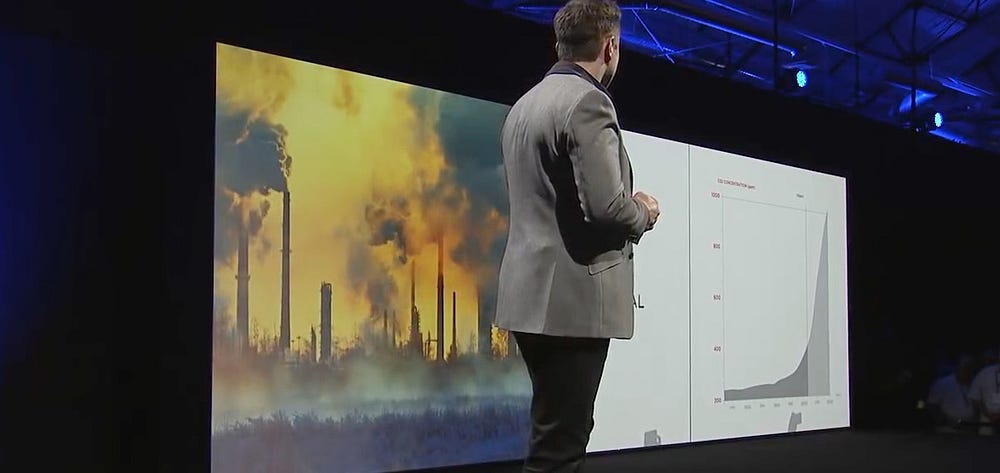
Three weeks ago, the CMO of a San Francisco startup backed by A-list investors emailed me about her new sales deck.
“It lacks oomph,” she said. “The information is there. The slides look great. But we’re not telling a compelling story. Can you help?”
One of my favorite things is helping entrepreneurs craft better pitches — for fundraising, sales, recruiting, whatever. I was busy with other projects and couldn’t start immediately, so I sent a link to the man on the CMO’s team who built the deck — a guy named Zack.
Five days later, the CMO texted me:
“Andy, what did you send Zack? Because his deck got a lot better. Kind of like night and day.”
What I sent Zack was a link to Elon Musk’s presentation for the Tesla Powerwall (the full video is at the bottom of this post). I also included a version of the points I’ll share below.
Musk’s delivery isn’t stellar. He’s self-conscious and fidgety. But at the end, his audience cheers. For a battery.
That’s because Musk does five things right that you should emulate in every pitch you ever make to anybody. And you should do them in this order:

Musk’s villain: fossil fuels
Never start a pitch by talking about yourself, your team, your product, or your total addressable market. Instead, start by naming the thing that’s getting in the way of your customer’s happiness. Do that by painting an emotionally resonant picture of how your customer is struggling, who/what is to blame, and why. When Musk shows this image of burning fossil fuels, you can practically hear Darth Vader’s ominous breath.

The Keeling Curve: growth of atmospheric CO2 concentration
Audiences — particularly investors — are skeptical. They’re thinking, “People have lived this way for a long time — are they really going to change now?” Musk handles this objection by showing that we’re at a critical point in the growth of atmospheric carbon dioxide concentration: If we don’t act now, things quickly get much, much worse. When Musk says, “We should collectively do something about this,” his audience howls in support.

Before saying anything about batteries, Musk describes his version of happily-ever-after: a civilization powered by “this handy fusion reactor in the sky, called the Sun.” Showing the enemy’s defeat before explaining how you’ll make it happen can feel wrong for novice presenters — like blurting out the punchline before you’ve told a joke. But when an audience knows where you’re headed, they’re much more likely to buckle in for the ride.
Now that you’ve shared your vision of the future, (a) lay out the obstacles to achieving it and (b) show how your company/product/service will overcome each one. (There had better be some big, nasty obstacles — otherwise who needs what you’re selling?)
Musk addresses three obstacles to a solar-powered world:
(i) The amount of energy produced by solar panels varies throughout the day and night (thus the need for batteries):

(ii) Most people think the land area required for batteries to store enough energy to rid U.S. of fossil fuels would be really huge (but according to Musk, it’s that tiny red dot in Texas):

(iii) Musk says that currently available batteries “suck” in seven specific ways:

By this point, Musk’s audience is practically salivating for the Powerwall product video, which will explain how Powerwall does not suck in each of those seven ways. But make no mistake: the fancy graphics and dramatic music only work because Musk has set up the Powerwall not as a battery, but as the salvation of mankind.

Look, Mom: No grid!
Again: audiences are skeptical. So you must give them evidence that the future you’ve laid out is, indeed, attainable. Musk does that by letting his audience in on a secret: Powerwall batteries have been supplying the energy for the auditorium in which he’s speaking. As proof, he zooms in on the meter above, which registers zero power from the grid.
For early- stage companies and products, demos like this can serve as evidence, though results from early (or beta) customers are more compelling. Least persuasive— but better than nothing — are testimonials from potential customers explaining why they would buy.
Here’s the full video of Musk’s launch announcement of the Tesla Powerwall. A few weeks after sending this to Zack, I worked with him and the CMO to make their pitch really hum, which was easier once we were on the same page about the elements of a compelling story. Now I’m thinking about asking all of my clients to watch this — before I engage — as a way to quickly communicate my happily-ever-after vision for them.
About Andy Raskin:
I help leaders tell strategic stories— for fundraising, sales, marketing, recruiting, and product management. My clients include teams funded by a16z, True Ventures, First Round Capital, KPCB, and other top venture investors. I also lead workshops on strategic storytelling and content strategy. To learn more or get in touch, visit http://andyraskin.com
Source of this article;
https://medium.com/firm-narrative/want-a-better-pitch-watch-this-328b95c2fd0b